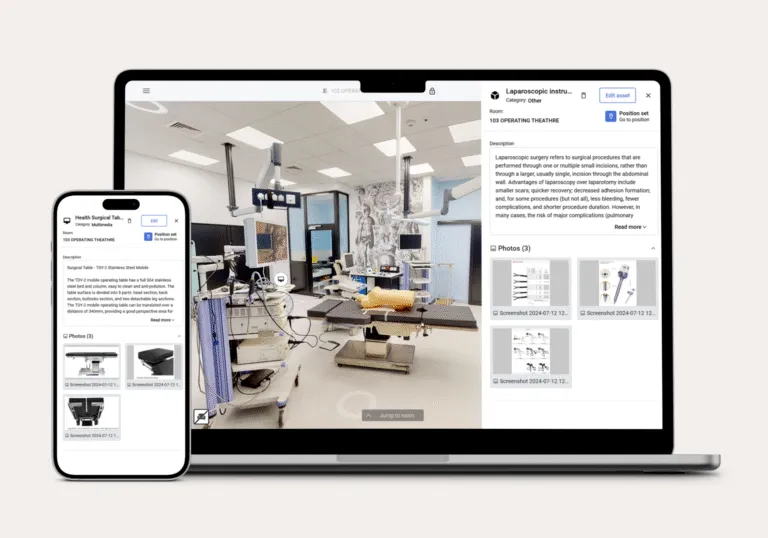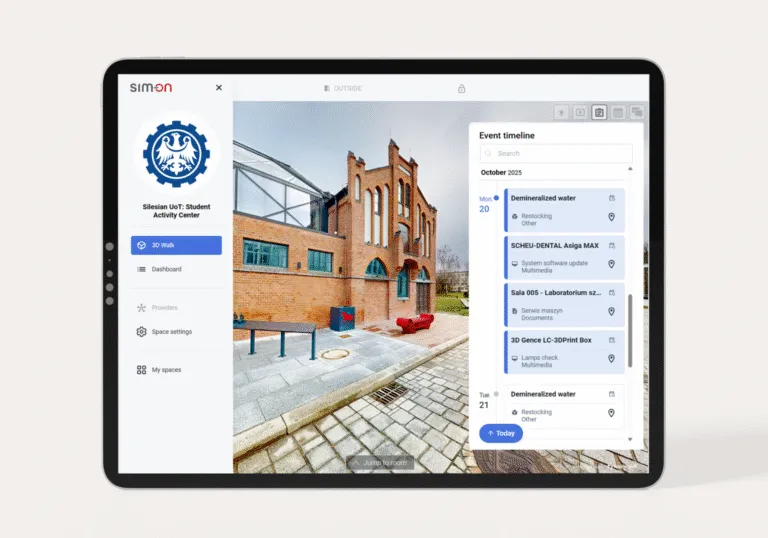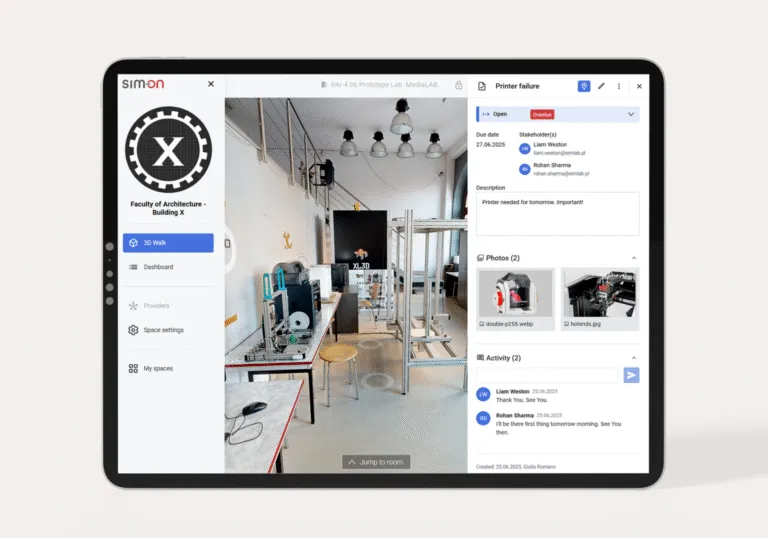Challenges and Context
Poland’s Silesian University of Technology operates as a leading technical education institution, maintaining an expansive campus network of teaching facilities, research laboratories, and administrative buildings. Managing this comprehensive academic infrastructure requires significant coordination efforts. Effective building maintenance necessitates ongoing technical monitoring, systematic inspection scheduling, and efficient data integration from various building automation systems (BMS). The university previously relied on analog documentation approaches—paper-based plans, 2D drawings, and dispersed spreadsheet databases.
These conventional methods created operational inefficiencies: identifying problems required extended timeframes, up-to-date equipment condition data remained inaccessible, and operating cost control faced impediments. Infrastructure information became distributed across departmental silos and file repositories, causing staff to spend excessive time locating data instead of implementing corrective actions.
To address these process limitations, Silesian University of Technology adopted advanced Digital Twin-based technologies. The project drew insights from Tokyo’s Toyo University implementation, where campus digital twin deployment significantly reduced failure response durations and lowered building management costs.
Professor Shuhei Tazawa’s research at Toyo University’s Faculty of Architecture showed air-conditioning system failure resolution times improved by 55%, translating to enhanced infrastructure restoration speed and decreased operational losses. These results encouraged university leadership to pursue real estate digitization initiatives. The institution formed a partnership with SIMLAB—specialists in Digital Twin technology, IoT system integration, and Facility Management tools—to develop comprehensive digital campus representation.

Solution Architecture
SIM-ON emerged as the essential platform, serving as the digital twin for designated Silesian University facilities. This innovative infrastructure management system employs 3D building scans as interactive interfaces for collecting and presenting vital facility data.
The initial implementation at EHTIC (European HealthTech Innovation Center) established data management standards, user onboarding protocols, and iterative development approaches that became blueprints for subsequent university buildings.
System functionality centers on virtual 3D models generated through Digital Twin technology—detailed building interior scans explorable via computer screens. These 3D models exceed simple visualization, functioning as central information hubs. Users (facility administrators, technical staff) navigate virtual models to immediately access relevant data associated with specific rooms or equipment.
SIM-ON unifies diverse facility management elements:
Scheduled Maintenance and Inspections: Buildings and technical installations maintain predetermined periodic check schedules linked to specific 3D model locations and devices. Systems automatically remind staff of upcoming inspections, while clicking model objects reveals completed service work history.
Technical Documentation Storage: Engineering blueprints, user manuals, installation diagrams, and acceptance certificates—previously maintained in physical binders or scattered files—are digitized and attached to corresponding model locations. Selecting virtual boiler rooms provides instant access to current heating system schematics or boiler documentation.
Fault Reporting and Communication: Personnel report failures or maintenance needs directly through 3D models by identifying rooms or devices and adding problem descriptions. Information automatically reaches appropriate Facility Management teams for prioritization and resolution tracking. All communications are recorded for comprehensive status visibility.
These capabilities operate within cohesive 3D environments. Rather than alternating between scheduling applications, documentation folders, and separate ticketing systems, university staff access unified campus digital twins. Interactive campus maps function as gateways—selecting buildings from map displays enables users to “enter” digital interiors containing necessary contextual information.

Staged Implementation Process
Maximizing digital twin potential required structuring the Silesian University project across multiple phases, allowing progressive milestone achievement, continuous learning, and solution adaptation. Primary stages included:
Digital Facility Capture and Inventory
Initial phases involved comprehensive scanning of selected campus buildings using Matterport cameras to generate realistic 3D interior models documenting rooms, corridors, equipment, and fixtures. Processes resembled virtual tour development—operators navigated spaces while devices captured complete 360° depth imagery. Scanning produced precise 3D models accessible through web browsers. SIMLAB teams constructed interactive campus maps featuring scanned buildings configured for data integration.
System Deployment and User Education
After model preparation, SIM-ON was launched and transferred to users. SIMLAB worked extensively with university administration to customize system configurations for campus-specific requirements. Data structures were established, and initial information packages were uploaded—inspection schedules, digitized technical documentation, and maintenance personnel contact information. Simultaneous training sessions and workshops prepared future users, covering fundamental 3D navigation through advanced capabilities like report generation and ticket filtering.
Integration, Enhancement, and Scaling
Following successful initial deployment, collaboration progressed into expansion phases. Future plans include platform extension to additional campus buildings, targeting comprehensive coverage of key university facilities. Each new 3D model undergoes comparable data integration procedures, joining central campus mapping systems. Parallel efforts integrate SIM-ON with existing building management systems and IoT sensors monitoring utility consumption.

Achievements and Impact
Initial months of SIM-ON utilization generated tangible benefits:
Response time improvements of 40% through consolidated facility information access
Comprehensive visual asset cataloging creating virtual resource inventories
Unified management environments eliminating multiple system dependencies
Enhanced inspection and audit efficiency via digitized scheduling and documentation
Maintenance cost optimization through improved asset control and condition monitoring
Streamlined operational workflows enhancing staff productivity through intuitive 3D interfaces
Strategic Vision
SIM-ON implementation at Silesian University represents successful collaboration between academic institutions and technology providers in creating innovative solutions. University infrastructure knowledge combined with SIMLAB’s technological expertise and commercial experience established new standards for campus management. Digital twin adoption has optimized operations, reduced response timeframes, and organized facility information systems.
This transformation establishes Silesian University as a pioneer among Polish public universities in Digital Twin infrastructure management, demonstrating that traditional academic facilities can successfully transition to digital building operations.
**#SmartUniversity #DigitalTransformation #CampusTechnology #3DVisualization #FacilityTech #InnovativeEducation #TechPartnership #SIMLAB #ModernCampus #InastructureInnovation



